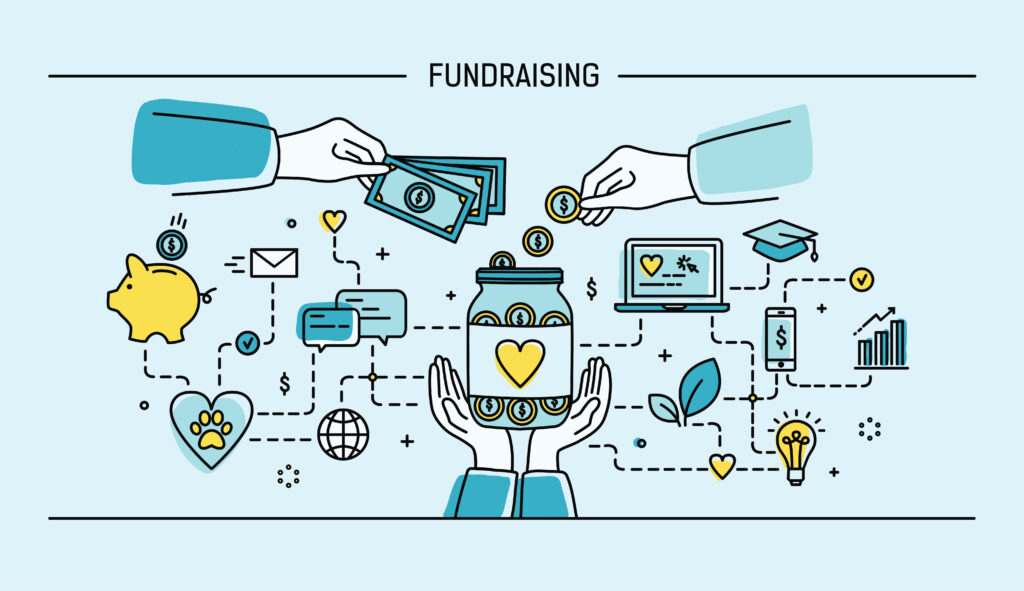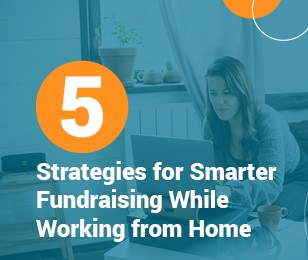Take a moment to think of your fundraising strategy like a rubber band.
If pressed, how much could you stretch this band?
A rigid, unyielding rubber band might snap under tension. In this scenario, a lack of flexibility in your fundraising plan could make it much more difficult to bounce back from a crisis. Instead of quickly adapting to change, you’re forced to pick up broken pieces before starting from scratch.
In contrast, a flexible fundraising plan will be more resilient. This rubber band can stretch and move to adjust to rapidly changing circumstances.
We’ll go ahead and drop the analogy. An adaptable fundraising strategy will enable you to respond gracefully and creatively to unexpected challenges like the COVID-19 pandemic.
At Aly Sterling Philanthropy, we partner with nonprofits to power strategic planning, fundraising, and board leadership solutions that allow them to thrive. Based on this extensive experience and our belief in the power of positivity, we recommend the following tips to enhance the flexibility of your fundraising strategy:
- Assess your current fundraising strategy.
- Lead with a strong case for support.
- Diversify your revenue streams.
- Offer versatile giving options.
While these suggestions are particularly applicable to the current circumstances, a strategic approach to fundraising will always be relevant. By embracing a fundraising plan that is adaptable, diverse and intentional, you’ll be well-positioned to drive your mission forward. Let’s get started.
- Assess your current fundraising strategy.
The best place to start when building a new fundraising strategy is evaluating the plan you currently have in place.
Is your current strategy sustainable and effective? Is it enabling you to reach your fundraising goals? Is it rigid and formulaic, or does it allow for adjustments as needs arise?

Dive into the data your nonprofit has collected from recent campaigns. If you already have a solid data management system in place, it should be simple to pull a report and evaluate the overall trends. Even if you have to take a little more time to compile a report manually, a deeper understanding of your current strategy will be well worth the effort.
This assessment will clarify which tactics are working well and which are underperforming or need improvements. Then, you can refocus your efforts on the most critical activities and make adjustments as needed.
While a full feasibility study isn’t practical unless you’re planning for a capital campaign, your data can still reveal a variety of actionable insights. For example, consider the following questions:
- What is your donor retention rate year-over-year? What about campaign-to-campaign?
- Have your recent fundraising goals been set at an attainable level?
- What percentage of your supporters participated in your last campaign? How does this differ across different types of campaigns?
- On what platform are your supporters most likely to engage with you? Do you have more success with email, direct mail or social media?
- Do you have a defined donor recognition policy? How do you convey appreciation to different categories of donors?
These are just a few of the questions to get you thinking about the state of your fundraising strategy. As you answer them with respect to 2020, take into account any challenges presented by the COVID-19 pandemic. If you experienced setbacks, what would have made the adjustment process run more smoothly?
Then, use this information to set your goal. Even a flexible fundraising plan needs a target! With an ambitious but achievable fundraising goal, your team will be energized and motivated to make it happen.
- Lead with a strong case for support.
Whether you’re preparing for a massive capital campaign or simply refreshing the text on your online donation page, you need a strong case for support.
This statement is what convinces donors why your nonprofit deserves their attention and contributions. Specifically, it should communicate your unique value proposition and share what sets your work apart from other organizations dedicated to similar causes. It should also align with your overall mission statement and strategic plan.
As you prepare your case for support, be sure to articulate the following elements:
- A clear vision. Do you have a well-defined plan to solve a demonstrated problem?
- A sense of urgency. Why should the prospect give now?
- An investment proposition. What results will the prospect’s gift be able to generate?
- A call to action. How can the prospect help you achieve your vision?
Overall, a strong case for support builds trust and faith in your organization. When your donors trust that you’ll use their gift wisely, they will continue to have confidence in your work even if you need to make a change.
Additionally, it will be easier to adjust your fundraising strategy if you have a strong foundation to build upon. Your case for support can act as your north star, guiding your efforts even in a turbulent environment.
3. Diversify your revenue streams.
One sign of an inflexible fundraising plan is total dependence on just one or two funding sources.
If your plan includes just a handful of major donors or relies on a large fundraising event, that could lead to a disastrous halt in your work if something falls through. Putting all of your fundraising eggs in one basket leaves you vulnerable to crisis or even just a change of heart.
By diversifying your revenue streams, your nonprofit will be more resilient and sustainable.
If the evaluation of your current fundraising strategy revealed little variation in your revenue streams, do your homework to explore new sources of funding.
For example, funding from foundations, government entities and other grant-giving institutions can make a huge difference in your bottom line. However, since they can be extremely competitive, it’s best to treat grant funding as unpredictable. In other words, don’t count your grant dollars before they’re in the door!
You could also consider exploring donor-advised funds (DAFs) as a potential source of revenue. A donor-advised fund is a giving vehicle that holds charitable assets for future contributions. These accounts are attractive to donors due to their financial benefits, as well as for being a hands-off approach. DAFs are managed by sponsoring organizations including community foundations and commercial sponsors. If your nonprofit forms a relationship with one of these sponsors, you may be connected to dozens or even hundreds of donors.
As you target one or more of these sources, be sure to tailor your ask appropriately. While you should tie each request for funding back to the same case for support, the language and appeals you use should be customized to the recipient. Then, after you’ve secured the funding, create a plan for intentionally stewarding this new relationship.
If this feels overwhelming on top of your usual workload, consider consulting an expert to help you identify and pursue new funding opportunities. As you start the consultant search, the Aly Sterling Philanthropy guide to hiring a fundraising consultant offers some helpful tips to find the right partner for your organization’s specific needs.
4. Offer versatile giving options.
In addition to diversifying your revenue streams, you should also diversify the opportunities that individual donors have to give.
As you approach each fundraising conversation, you should have a number in mind based on your previous prospect research, gift range chart, and overall goal. But if the answer to that request is a no, come armed with alternatives.
Think of these options less like a back-up plan and more as a solution for donors who are passionate about your mission but currently unable to make a major gift. You might present the following alternative giving opportunities:
- Recurring gift program. Consider amping up your recurring gift program to create a predictable revenue stream. Even small monthly gifts can make an impact when multiplied over the course of the year, and they’re often more accessible to a wider range of your supporters.
- Matching gifts. Many companies will match employee gifts to eligible 501(c)(3) nonprofit organizations, but sometimes these programs are underutilized. According to re:Charity’s guide to matching gifts, somewhere between $4 and $7 billion dollars in matching gift revenue goes unclaimed every year. To maximize this potentially valuable funding source, spread awareness of matching gifts among your supporters or use a dedicated database to identify gifts that could be submitted for a match.
- Pledged gifts. Allow donors to commit to supporting your cause at a future date without needing to pull out their checkbooks just yet. By counting on pledges of a certain amount later in the year, you can better plan for future funding while giving the donor time to plan for the gift.
Loyal supporters will appreciate this flexibility if they experience any financial setbacks. And when the economy recovers (as it always does), your relationships with these supporters will still be thriving.
Bonus Tip: Consider bringing in a consultant to provide expertise and perspective as you develop your flexible fundraising strategy. Most importantly, the right consultant can help you prioritize relationships with supporters and facilitate even deeper connections. This list of nonprofit consultants includes firms in different areas of expertise, including stewardship. Even if your exact plans for gift solicitation need to change, you’ll still need to rely on relationships to pursue your mission.
As we move into 2021, it’s time to refocus your efforts and create a fundraising strategy that can weather any storm. By leading with relationships and a flexible approach, you’ll be better able to reach your fundraising goals. Good luck!
About the Author: Aly Sterling

Long before Aly Sterling founded her eponymous consulting firm, she was solving the unique yet similar problems encountered by nonprofit organizations.
Her decision to start her own business in 2007 was driven by her belief in leadership as the single most important factor in organizational success, and her determination to work with multiple causes at one time to scale societal change.
Aly’s expertise includes fundraising, strategic planning, search consultation and board leadership development for the well-positioned nonprofit. She is regularly sought for comment by trade and mainstream media, including the Chronicle of Philanthropy and U.S. News & World Report. She has contributed to publications of BoardSource and The Governance Institute, as well as the Toledo Chamber of Commerce and The Giving Institute.


